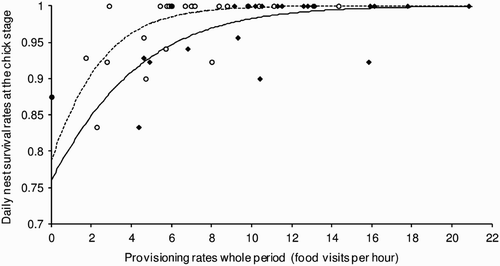Figures & data
Figure 1. Relationship between daily nest survival rates of Lesser Spotted Woodpeckers at the chick stage and provisioning rates per hour during the chick stage.
— •, combined adults; ––– ○, males only.

Figure 2. Mean (± se) male and female provisioning rates of Lesser Spotted Woodpeckers at the early- and late-chick stages. Comparisons are of nests with two parents present in the early-chick stage and late-chick stage and late-stage nests with male only.
White bars represent data from the present study; dotted bars represent data from studies in Sweden showing that the male can compensate for the female being absent (reproduced from Wiktander et al. [2000] with permission of the author and John Wiley & Sons Ltd.); in the ‘Late, male-only nests’ columns, the observed data are presented alongside those expected from the males if they are fully compensating for the loss of a female (the sum of the late male and female values from each study).
![Figure 2. Mean (± se) male and female provisioning rates of Lesser Spotted Woodpeckers at the early- and late-chick stages. Comparisons are of nests with two parents present in the early-chick stage and late-chick stage and late-stage nests with male only. White bars represent data from the present study; dotted bars represent data from studies in Sweden showing that the male can compensate for the female being absent (reproduced from Wiktander et al. [2000] with permission of the author and John Wiley & Sons Ltd.); in the ‘Late, male-only nests’ columns, the observed data are presented alongside those expected from the males if they are fully compensating for the loss of a female (the sum of the late male and female values from each study).](/cms/asset/598f22fe-34fa-408a-8339-70dc3642621a/tbis_a_662941_o_f0002g.gif)
Figure 3. The relationship between rainfall and chick-stage daily nest failure rates in Lesser Spotted Woodpeckers.
The solid line shows the modelled relationship, with open circles showing the actual data.
